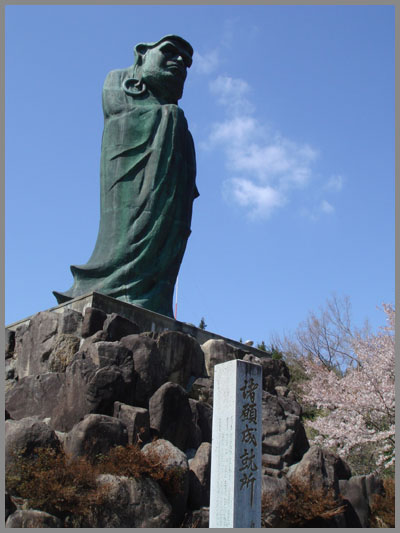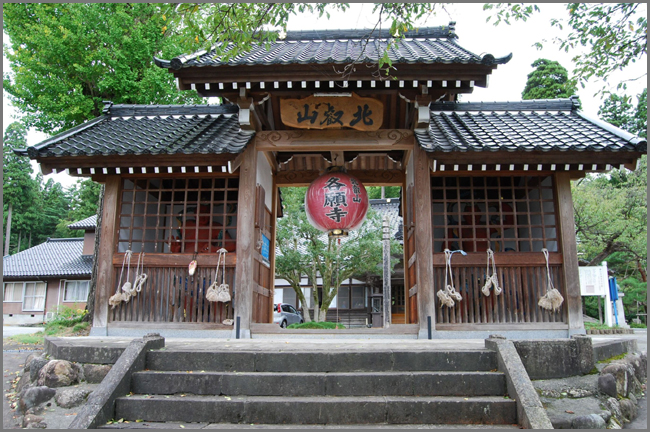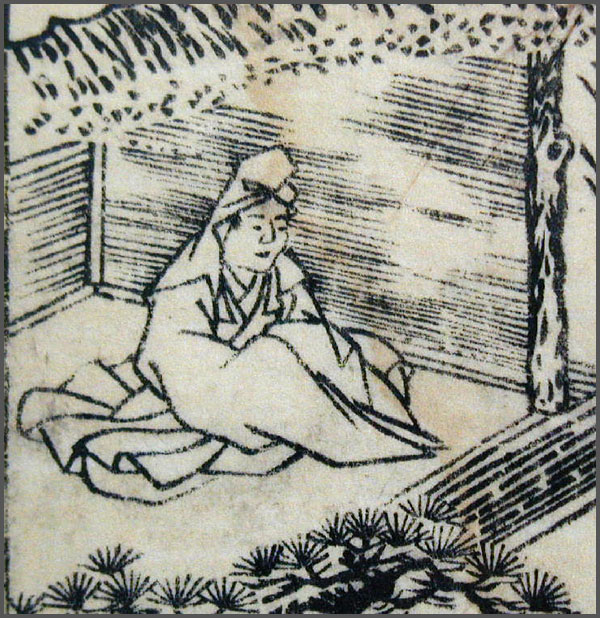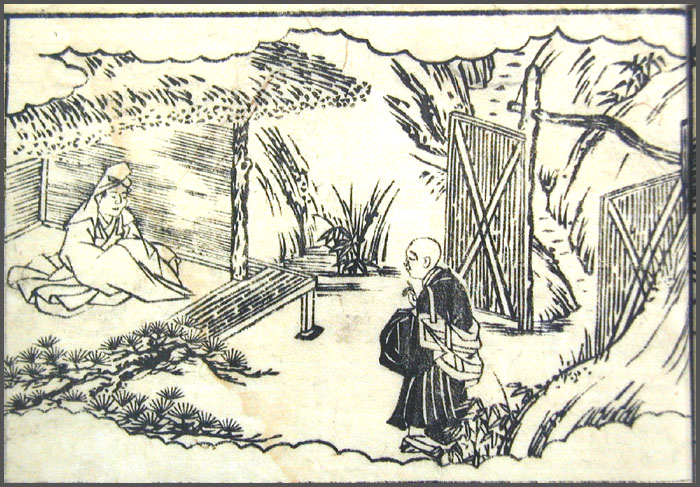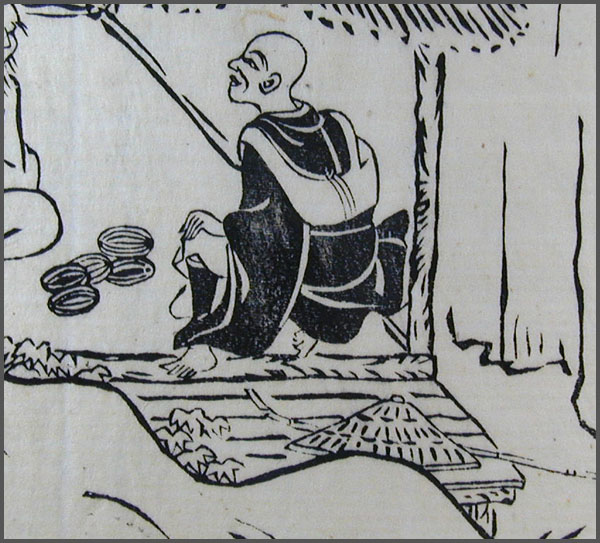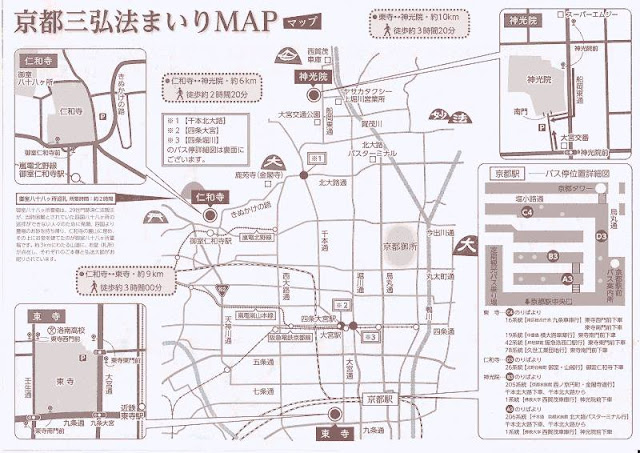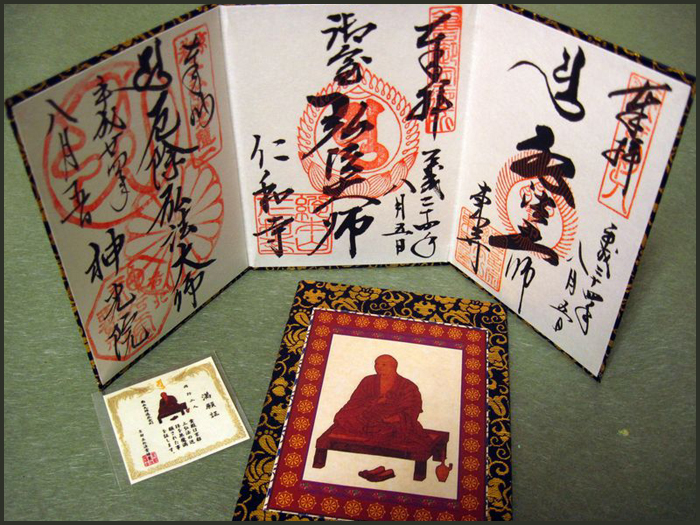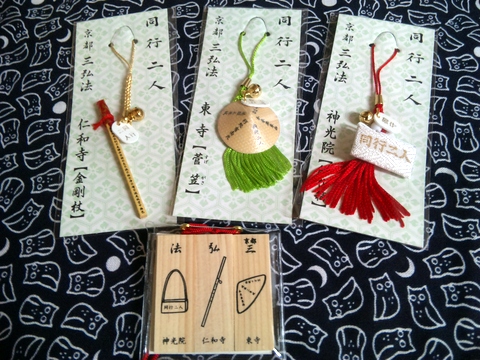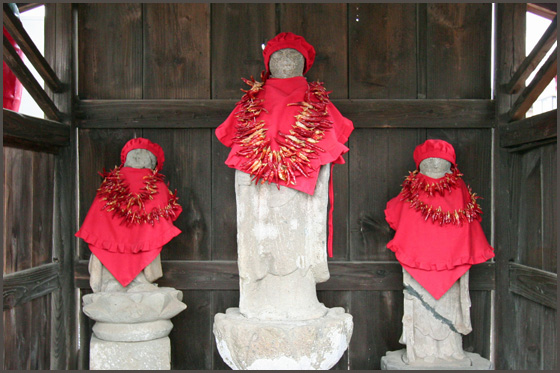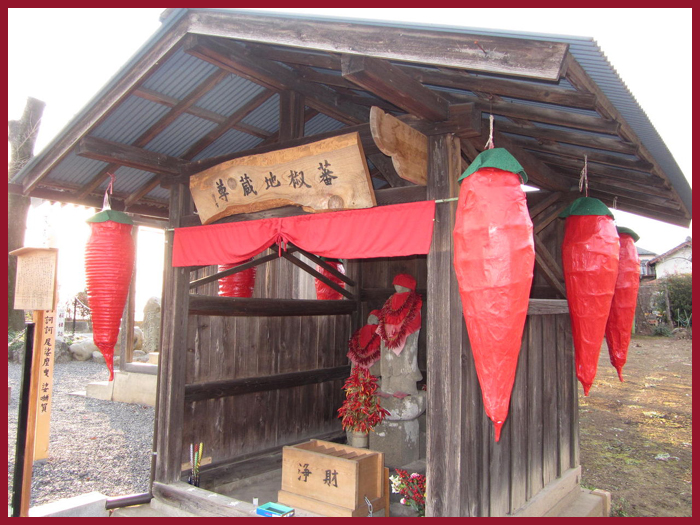[ . BACK to DARUMA MUSEUM TOP . ]
. - - - - - ABC-List of the Sennin Immortals Hermits - - - - - .
. sennin 仙人と伝説 Legends about Immortals .
::::::::::::::::::::::::::::::::::::::::::::::::::::::::::::::::::::::::::::::::::::::::::::::::::::::::::::::::::::::::::::::::::::::::::::::::::::::::::::::::::::::::::::::
Udohama Nyosen 宇度浜女仙 female Sennin from Udohama beach
and 漁夫 her husband, a fisherman
She is Nr. 02 of the
. 日本の仏仙人16人 - The 16 Buddhist Immortals of Japan .
Udohama 宇度濱(うどはま)/ 有度浜 / 宇土浜 / 宇渡浜(うとはま) Utohama
In Shizuoka, 駿河国宇度郡 Suruga, Udo District, near 三保の松原 Miho no Matsubara.
Not much is known about this heavenly maiden. She appeared at the beach of Udohama and became the wife of a fisherman.
![]()
西村重長 Nishimura Shigenaga (1697 - 1758)
A dance performed by a heavenly maiden who arrived at Udohama, Suruga Province in the reign of Emperor Ankan is known.
安閑天皇の御世、駿河国の宇土浜に天女が降って舞ったものを模したという.
. Miho no matsubara 三保の松原 Miho pine grove .
![]()
Miho no Matsubara is known as the site of the legend of Hagoromo 羽衣 "the Feathered Robe",
which is based on the traditional swan maiden motif.
The story of Hagoromo concerns a celestial being flying over Miho no Matsubara who was overcome by the beauty of the white sands, green pines, and sparkling water. She removed her feathered robe and hung it over a pine tree before bathing in the beautiful waters.
A fisherman named Hakuryo was walking along the beach and saw the angel. He took her robe and refused to return it until she performed a heavenly dance for him. As the angel could not return to heaven without her robe, she complied with Hakuryo's request. She danced in the spring twilight and returned to heaven in the light of the full moon leaving Hakuryo looking longingly after her.
- quote wikipedia -
![]()
歌川国貞 Utagawa Kunisada (1786 - 1865)
Udohama and Yoshinoyama are stories of two tennyo天女 heavenly maidens.
::::::::::::::::::::::::::::::::::::::::::::::::::::::::::::::::::::::::::::::::::::::::::::::::::::::::::::::::::::::::::::::::::::::::::::::::::::::::::::::::::::::::::::::
Yoshinoyama Nyosen 吉野山女仙 Female Sennin from Mount Yoshinoyama
She is Nr. 03 of the
. 日本の仏仙人16人 - The 16 Buddhist Immortals of Japan .
She lived during the time of 天武天皇 Emperor Tenmu (631 - 686)
吉野山二女仙 indicates that there were two of them.
. Tenmu, Tenbu 天武天皇 Emperor Tenmu Tenno .
Prince Ōama 大海人皇子 Oama no Oji
Prince Oama pretended to be a monk at the temple in Yoshino,
tennyo 天女 the Heavenly Maiden
Once Tenmu Tenno played the 琴 Koto near a waterfall in Yoshino. On the cliff opposite the river something strange like a colorful cloud appeared. Looking closer it had the form of 天女 two heavenly maiden, clad in traditional layered robes, performing a ritual dance.
![]()
This is the beginning of the ritual gosetchi no maihime五節の舞姫 Gosechi no Mai .
This imperial dance is performed to our day, even in Kabuki.
![]()
- more photos source : deep.wakuwaku-nara.com/kiyomi -
吉野川 - 天皇淵 Yoshinogawa Tenno-Buchi Tenno Riverpool at river Yoshinogawa
Nearby is the shrine 浄見原神社 Kiyomihara Jinja.
Tenmu Tenno was quite taken by the dance of the Heavenly Maiden. He composed a poem:
おとめ子が乙女さびしもからたまを袂にまきておとめさびしも
をとめども をとめさひする 唐たまを たもとにまきて をとめさびすも
::::::::::::::::::::::::::::::::::::::::::::::::::::::::::::::::::::::::::::::::::::::::::::::::::::::::::::::::::::::::::::::::::::::::::::::::::::::::::::::::::::::::::::::
. 04 Suzuka no okina 鈴鹿翁(すずかのおきな) Old Man Suzuka .
is also related to Tenmu, Tenbu 天武天皇 Emperor Tenmu Tenno
when he was still Prince Ōama 大海人皇子 Oama no Oji and lived in exile in Yoshino.
::::::::::::::::::::::::::::::::::::::::::::::::::::::::::::::::::::::::::::::::::::::::::::::::::::::::::::::::::::::::::::::::::::::::::::::::::::::::::::::::::::::::::::::
. tennyo 天女, hiten 飛天 "heavenly maiden"
flying Apsara, divine nymph, celestial maiden .
![]()
::::::::::::::::::::::::::::::::::::::::::::::::::::::::::::::::::::::::::::::::::::::::::::::::::::::::::::::::::::::::::::::::::::::::::::::::::::::::::::::::::::::::::::::
. sennin 天狗と仙人伝説 Legends about Tengu and Immortals .
. sennin 仙人と伝説 Legends about Immortals .
. Japan - Shrines and Temples - Index .
[ . BACK to DARUMA MUSEUM . TOP . ]
[ . BACK to WORLDKIGO . TOP . ]
- - #senninudohama #udohamasennin #senninyoshinoyama #yoshinoyamasennin-
::::::::::::::::::::::::::::::::::::::::::::::::::::::::::::::::::::::::::::::::::::::::::::::::::::::::::::::::::::::::::::::::::::::::::::::::::::::::::::::::::::::::::::::
. - - - - - ABC-List of the Sennin Immortals Hermits - - - - - .
. sennin 仙人と伝説 Legends about Immortals .
::::::::::::::::::::::::::::::::::::::::::::::::::::::::::::::::::::::::::::::::::::::::::::::::::::::::::::::::::::::::::::::::::::::::::::::::::::::::::::::::::::::::::::::
Udohama Nyosen 宇度浜女仙 female Sennin from Udohama beach
and 漁夫 her husband, a fisherman
She is Nr. 02 of the
. 日本の仏仙人16人 - The 16 Buddhist Immortals of Japan .
Udohama 宇度濱(うどはま)/ 有度浜 / 宇土浜 / 宇渡浜(うとはま) Utohama
In Shizuoka, 駿河国宇度郡 Suruga, Udo District, near 三保の松原 Miho no Matsubara.
Not much is known about this heavenly maiden. She appeared at the beach of Udohama and became the wife of a fisherman.

西村重長 Nishimura Shigenaga (1697 - 1758)
A dance performed by a heavenly maiden who arrived at Udohama, Suruga Province in the reign of Emperor Ankan is known.
安閑天皇の御世、駿河国の宇土浜に天女が降って舞ったものを模したという.
. Miho no matsubara 三保の松原 Miho pine grove .

Miho no Matsubara is known as the site of the legend of Hagoromo 羽衣 "the Feathered Robe",
which is based on the traditional swan maiden motif.
The story of Hagoromo concerns a celestial being flying over Miho no Matsubara who was overcome by the beauty of the white sands, green pines, and sparkling water. She removed her feathered robe and hung it over a pine tree before bathing in the beautiful waters.
A fisherman named Hakuryo was walking along the beach and saw the angel. He took her robe and refused to return it until she performed a heavenly dance for him. As the angel could not return to heaven without her robe, she complied with Hakuryo's request. She danced in the spring twilight and returned to heaven in the light of the full moon leaving Hakuryo looking longingly after her.
- quote wikipedia -

歌川国貞 Utagawa Kunisada (1786 - 1865)
Udohama and Yoshinoyama are stories of two tennyo天女 heavenly maidens.
::::::::::::::::::::::::::::::::::::::::::::::::::::::::::::::::::::::::::::::::::::::::::::::::::::::::::::::::::::::::::::::::::::::::::::::::::::::::::::::::::::::::::::::
Yoshinoyama Nyosen 吉野山女仙 Female Sennin from Mount Yoshinoyama
She is Nr. 03 of the
. 日本の仏仙人16人 - The 16 Buddhist Immortals of Japan .
She lived during the time of 天武天皇 Emperor Tenmu (631 - 686)
吉野山二女仙 indicates that there were two of them.
. Tenmu, Tenbu 天武天皇 Emperor Tenmu Tenno .
Prince Ōama 大海人皇子 Oama no Oji
Prince Oama pretended to be a monk at the temple in Yoshino,
tennyo 天女 the Heavenly Maiden
Once Tenmu Tenno played the 琴 Koto near a waterfall in Yoshino. On the cliff opposite the river something strange like a colorful cloud appeared. Looking closer it had the form of 天女 two heavenly maiden, clad in traditional layered robes, performing a ritual dance.

This is the beginning of the ritual gosetchi no maihime五節の舞姫 Gosechi no Mai .
This imperial dance is performed to our day, even in Kabuki.

- more photos source : deep.wakuwaku-nara.com/kiyomi -
吉野川 - 天皇淵 Yoshinogawa Tenno-Buchi Tenno Riverpool at river Yoshinogawa
Nearby is the shrine 浄見原神社 Kiyomihara Jinja.
Tenmu Tenno was quite taken by the dance of the Heavenly Maiden. He composed a poem:
おとめ子が乙女さびしもからたまを袂にまきておとめさびしも
をとめども をとめさひする 唐たまを たもとにまきて をとめさびすも
::::::::::::::::::::::::::::::::::::::::::::::::::::::::::::::::::::::::::::::::::::::::::::::::::::::::::::::::::::::::::::::::::::::::::::::::::::::::::::::::::::::::::::::
. 04 Suzuka no okina 鈴鹿翁(すずかのおきな) Old Man Suzuka .
is also related to Tenmu, Tenbu 天武天皇 Emperor Tenmu Tenno
when he was still Prince Ōama 大海人皇子 Oama no Oji and lived in exile in Yoshino.
::::::::::::::::::::::::::::::::::::::::::::::::::::::::::::::::::::::::::::::::::::::::::::::::::::::::::::::::::::::::::::::::::::::::::::::::::::::::::::::::::::::::::::::
. tennyo 天女, hiten 飛天 "heavenly maiden"
flying Apsara, divine nymph, celestial maiden .

::::::::::::::::::::::::::::::::::::::::::::::::::::::::::::::::::::::::::::::::::::::::::::::::::::::::::::::::::::::::::::::::::::::::::::::::::::::::::::::::::::::::::::::
. sennin 天狗と仙人伝説 Legends about Tengu and Immortals .
. sennin 仙人と伝説 Legends about Immortals .
. Japan - Shrines and Temples - Index .
[ . BACK to DARUMA MUSEUM . TOP . ]
[ . BACK to WORLDKIGO . TOP . ]
- - #senninudohama #udohamasennin #senninyoshinoyama #yoshinoyamasennin-
::::::::::::::::::::::::::::::::::::::::::::::::::::::::::::::::::::::::::::::::::::::::::::::::::::::::::::::::::::::::::::::::::::::::::::::::::::::::::::::::::::::::::::::




